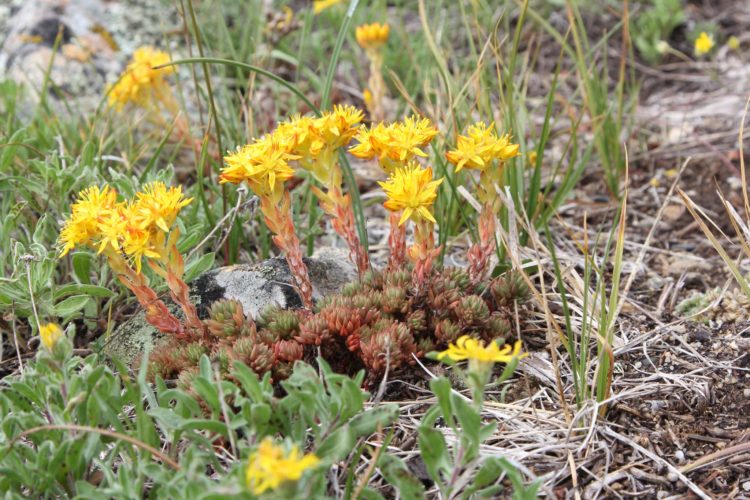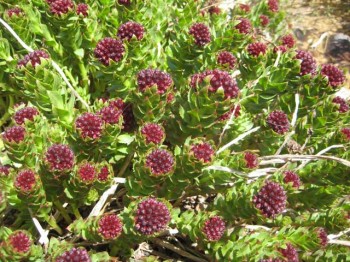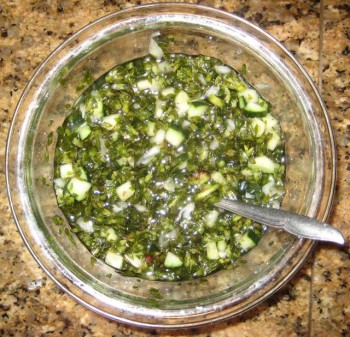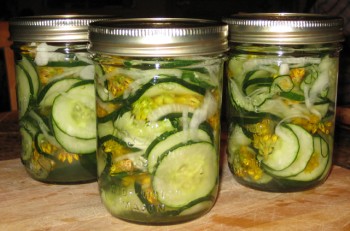
Succulents are juicy plants that store water in their leaves, stems, and roots, an adaptation which helps them survive in arid climates or soil conditions. Aloe, agave, sedums and purslane are some examples.
Although “dry” is not a word I’d use to describe the high country right now, it often is dry, and so the timeless succulents are there, now sucking up this season’s water bounty and growing like crazy like everything else.
A few edible succulent plants that grow in the Colorado high country are yellow stonecrop (Sedum lanceolatum), roseroot (Rhodiola integrifolia), and rosecrown (Rhodiola rhodantha). All of these plants are thriving right now.

Roseroot, Onions & Soy Sauce Debacle
The other day in search of some variety in my wild diet, I gathered a big handful of roseroot or King’s crown, the succulent that blooms into a flat-topped, blood-red flower clusters. I took some newly flowering plants, mixed with very young not-yet-flowering ones.
Roseroot and its close relative–rosecrown or Queen’s crown–look quite similar and often grow near each other. Rosecrown has a roundish, cone-shaped, pink to whitish flower cluster on top–somewhat akin to a clover–in contrast with roseroot’s flat, ruby-red red one. Both can be used interchangeably.
It had been a while since I consumed these rosy succulents, so at home I reread my notes, finding I was “enthralled” by roseroot shoots boiled for 4 minutes and then lightly fried with finely chopped onions and soy. So I tried the same recipe again and the darn roseroot came out impossibly bitter. Not just bad, but horribly bad—disgusting, if you will. Sometimes it’s hard to trust my past self. I think I was so excited about edible wild plants, I liked everything. Time to experiment some more.

I decided to try my grandmother’s icebox sweet pickle recipe (below). This has always worked great with yellow stonecrop (Sedum lanceolatum), another local succulent I enjoy using. It came out pretty good with the roserooot except for the texture, which was drying and squeaky. Fortunately, fine-chopping the succulent pickles into relish did the trick. For what it’s worth, I often find that fine-chopping helps with tricky wild edibles.
Sweet Pickles with Stonecrop Flowers
My favorite succulent to use in Grandma’s pickles is yellow stonecrop, a wild species common from the middle to high elevations in Colorado. The flowering stems of this plant can be clipped (sparingly, spreading out your harvest) prior to flowering–wherever the stem is still bendable and hasn’t toughened up, which it does from the bottom up–for succulent bits that work well in a pickle. After flowering the stems are quite tough, at which point I just collect the very top leaves along with their bright flowers, as I did for this go-round. It is good to wash the wild ingredients well to avoid grit in your pickles—and this is one plant you should definitely not harvest from the side of a dusty road, which I know from experience.
Grandma’s Icebox Sweet Pickles (with Wild Succulents)
Ingredients:

- 2 quarts cucumbers, thinly-sliced
- 1 onion, thinly sliced
- wild succulents
- 2tbs salt
- 1½ cups sugar
- ½ cup vinegar
Instructions:
Wash the wild ingredients and chop if necessary. Thinly slice the cucumbers (leaving the skins on) and the onion, aiming for 2 quarts of sliced cucumbers. Slicing can be done by hand or with a food processor to speed it up. Cover sliced cucumbers, onion, and succulents with water in a bowl and add salt; mix; and let stand for two hours. Drain water and add sugar, mixing until veggies are fully coated, then add vinegar and mix again. Store in the “icebox.” Mine keep for a few months, though I generally eat them faster than that.
Updated 3.2.21

Leave a Reply